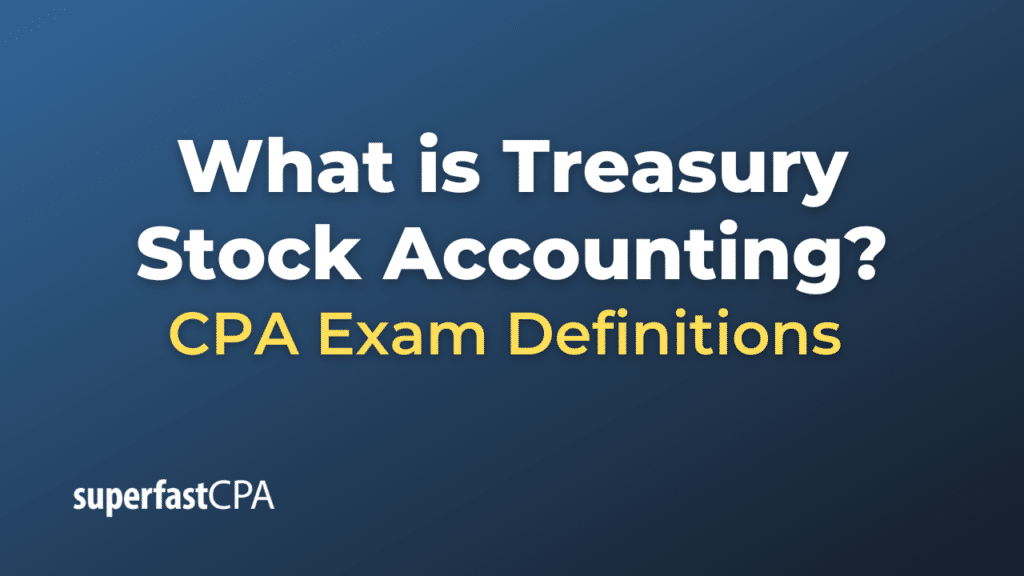Treasury Stock Accounting
Treasury stock accounting involves tracking and recording transactions related to a company’s buyback of its own shares. When a company repurchases its own stock, those shares become treasury stock. They are no longer considered outstanding but remain issued. As such, treasury stock doesn’t receive dividends, doesn’t have voting rights, and isn’t used in the computation of earnings per share.
Here’s a step-by-step look at treasury stock accounting:
- Purchase of Treasury Stock:
- When a company buys back its shares, it debits (increases) the “Treasury Stock” account and credits (decreases) “Cash” or another relevant account.
- The “Treasury Stock” account is a contra equity account, meaning it reduces total shareholders’ equity on the balance sheet.
- Sale of Treasury Stock Above Cost:
- If the company later sells its treasury stock for more than its cost, it credits (increases) the “Treasury Stock” account for the cost of the shares, credits (increases) “Cash” or another relevant account for the total sale proceeds, and the difference (the excess over cost) is typically credited to an equity account like “Paid-in Capital from Treasury Stock.
- Sale of Treasury Stock Below Cost :
- If the company sells its treasury stock for less than its cost, it credits the “Treasury Stock” account for the cost of the shares, credits “Cash” or another relevant account for the sale proceeds, and the difference (the deficit under cost) is typically debited from “Paid-in Capital from Treasury Stock” (to the extent that there are any balances from previous treasury stock transactions). If there isn’t enough balance in the paid-in capital account, the remainder might be debited from retained earnings.
- Retiring Treasury Stock:
- If a company decides to permanently retire treasury shares (meaning they won’t be reissued in the future), it can remove the shares from the issued stock category altogether. This often involves adjusting the “Common Stock” and “Paid-in Capital” accounts, effectively reversing part or all of the original issuance entry.
It’s essential to understand that the specific accounting treatment can vary based on the accounting standards in use (e.g., US GAAP vs. IFRS) and may differ slightly based on specific circumstances or company policies.
Lastly, while the purchase of treasury stock reduces shareholders’ equity (because it’s a use of company resources to buy back shares), it doesn’t affect the company’s net income, as it’s a balance sheet-only transaction.
Example of Treasury Stock Accounting
Let’s delve into a hypothetical scenario to demonstrate treasury stock accounting.
Scenario:
Imagine a company named “BlueWave Inc.” decides to buy back its own shares from the open market.
- Purchase of Treasury Stock:
- BlueWave Inc. repurchases 10,000 shares at $10 per share for a total of $100,000.
| Account | Debit (DR) | Credit (CR) |
|---|---|---|
| Treasury Stock | $100,000 | |
| Cash | $100,000 |
This entry reflects the fact that BlueWave spent $100,000 cash to repurchase its own shares, and these shares are now held as treasury stock.
- Sale of Treasury Stock Above Cost:
- Later, BlueWave Inc. decides to sell 5,000 of these treasury shares for $12 per share, totaling $60,000.
| Account | Debit (DR) | Credit (CR) |
|---|---|---|
| Cash | $60,000 | |
| Treasury Stock | $50,000 | |
| Paid-in Capital from Treasury Stock | $10,000 |
Here, the treasury stock account is credited for the cost of the treasury shares sold ($10 * 5,000). The excess $2 per share ($12 – $10) received over the cost, amounting to $10,000, is credited to the “Paid-in Capital from Treasury Stock” account.
- Sale of Treasury Stock Below Cost:
- Later still, BlueWave Inc. decides to sell another 3,000 treasury shares, but this time for $8 per share, totaling $24,000.
Journal Entry:
| Account | Debit (DR) | Credit (CR) |
|---|---|---|
| Cash | $24,000 | |
| Paid-in Capital from Treasury Stock | $6,000 | |
| Treasury Stock | $30,000 |
Here, the treasury stock account is credited for the cost of the treasury shares sold ($10 * 3,000). The deficit of $2 per share ($10 – $8) below the cost, amounting to $6,000, is debited from the “Paid-in Capital from Treasury Stock” account.
This example illustrates the basic treasury stock transactions a company might encounter. Do remember that in actual practice, further complexities might arise, especially when there aren’t enough credit balances in accounts like “Paid-in Capital from Treasury Stock” to absorb deficits from sales below cost. In such cases, retained earnings might also be debited.













